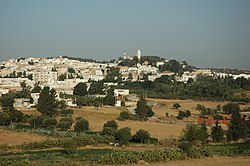Zaghouan
Zaghwan (or Zaghouan; Arabic: زغوان ![]() Zaġwān) is a town in the northern half of Tunisia.
Zaġwān) is a town in the northern half of Tunisia.
Zaghouan
زغوان | |
|---|---|
 Zaghouan Governorate | |
| Coordinates: 36°24′N 10°09′E / 36.400°N 10.150°E | |
| Country | |
| Governorate | Zaghouan Governorate |
| Population (2014) | |
| • Total | 20,837 |
| Time zone | UTC+1 (CET) |
Situated on a low ridge of the Dorsale Mountains, the town has a mild climate and presents a green aspect. Cold water from here was taken by aqueduct to Carthage. The town is famous for its roses, originally cultivated by Muslim refugees from Spain in the seventeenth century. The town is located around 100 km due south of Tunis and around 50 km inland (west) from the Gulf of Hammamet and has an estimated population of around 20,837 (2014). It is the capital of the Zaghouan Governorate.
On the mountain south of the city is the Roman Water Temple Djebel Zaghouan (Temple de Eaux), source of an aqueduct which used to take water to the city of Carthage over 100 km away. The ruins here are illustrated in Fisher's Drawing Room Scrap Book, 1840, as 'Temple and Fountain of Zagwhan', the subject of a poem by Letitia Elizabeth Landon.
Gallery
change-
Postcard of Zaghouan in 1900
-
Zaghouan in Tunisia
-
Tunisie Parc on Djebel Zaghouan
References
change
